Anglo-French Channel Tunnel Project: Cultural and Business Impacts
VerifiedAdded on 2023/01/19
|13
|1134
|49
Presentation
AI Summary
This presentation examines the Channel Tunnel project, a unique technological endeavor involving British and French collaboration. It explores the differing management styles and national characteristics, including the French emphasis on decision-making autonomy and the British procedural approach. The report applies Hofstede's cultural dimensions, such as power distance and individualism vs. collectivism, to analyze the project's cross-cultural communication and its impact on business settings. It highlights challenges faced by both nations, such as procedural differences, and identifies the benefits of the Channel for international businesses, including enhanced marketing strategies and global market expansion. The presentation concludes by emphasizing the importance of effective channels for organizational performance and international recognition, with references to relevant academic sources.

PowerPoint
Presentation
Presentation
Paraphrase This Document
Need a fresh take? Get an instant paraphrase of this document with our AI Paraphraser

INTRODUCTION
The channel tunnel was a unique technologically project. The two
nations British and French was indulged in the process of channel
tunnel. The French managers had importantly more decision making
autonomy and work.
The both British and French nationalities had effective personal
accountabilities. French had high advance technologies and more
controlling power of their work. British were more procedural and the
French were most action oriented country. In this both country were
no differences related to the job motivation and satisfaction from
promotion and pay.
The channel tunnel was a unique technologically project. The two
nations British and French was indulged in the process of channel
tunnel. The French managers had importantly more decision making
autonomy and work.
The both British and French nationalities had effective personal
accountabilities. French had high advance technologies and more
controlling power of their work. British were more procedural and the
French were most action oriented country. In this both country were
no differences related to the job motivation and satisfaction from
promotion and pay.
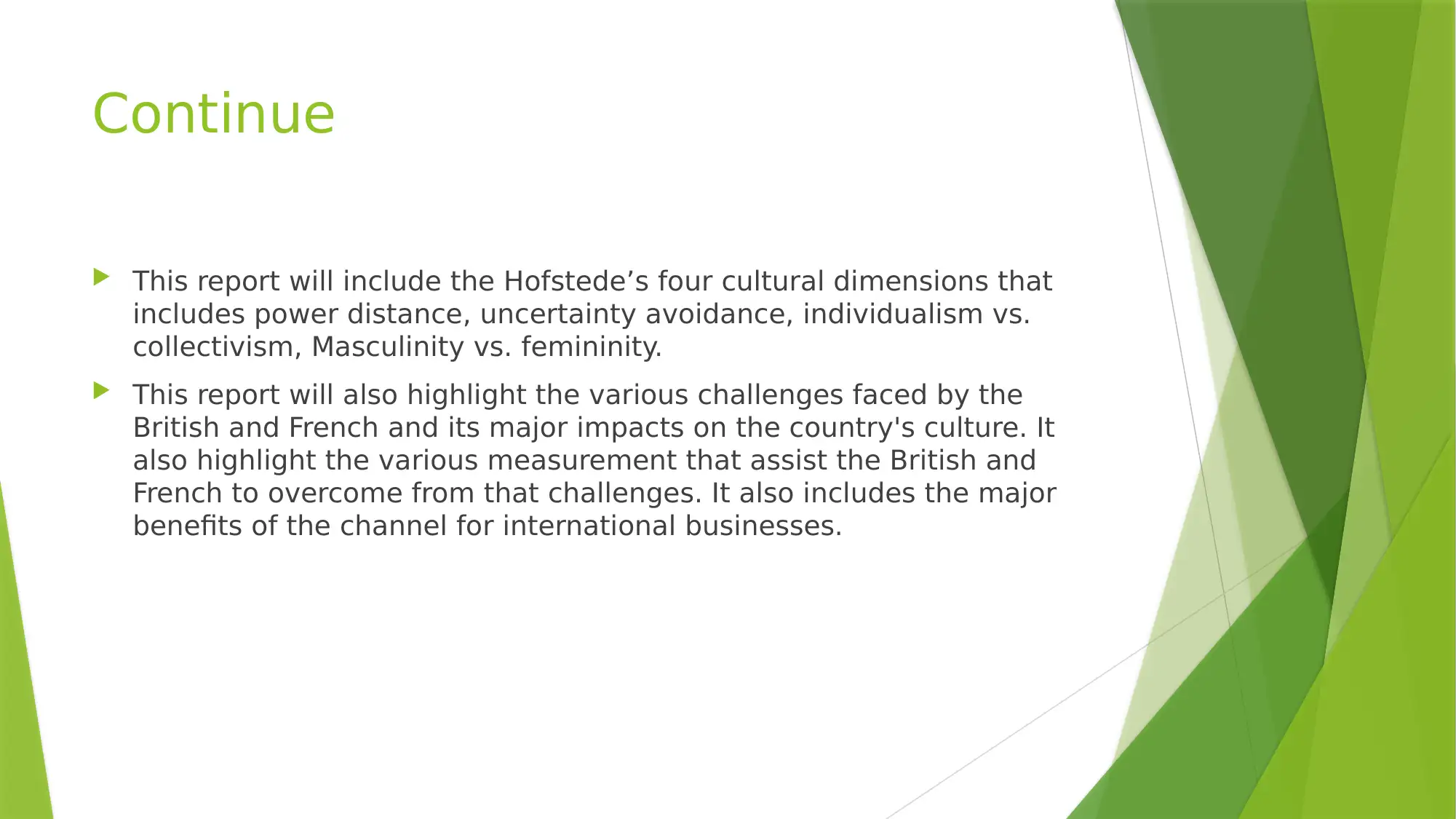
Continue
This report will include the Hofstede’s four cultural dimensions that
includes power distance, uncertainty avoidance, individualism vs.
collectivism, Masculinity vs. femininity.
This report will also highlight the various challenges faced by the
British and French and its major impacts on the country's culture. It
also highlight the various measurement that assist the British and
French to overcome from that challenges. It also includes the major
benefits of the channel for international businesses.
This report will include the Hofstede’s four cultural dimensions that
includes power distance, uncertainty avoidance, individualism vs.
collectivism, Masculinity vs. femininity.
This report will also highlight the various challenges faced by the
British and French and its major impacts on the country's culture. It
also highlight the various measurement that assist the British and
French to overcome from that challenges. It also includes the major
benefits of the channel for international businesses.
⊘ This is a preview!⊘
Do you want full access?
Subscribe today to unlock all pages.

Trusted by 1+ million students worldwide
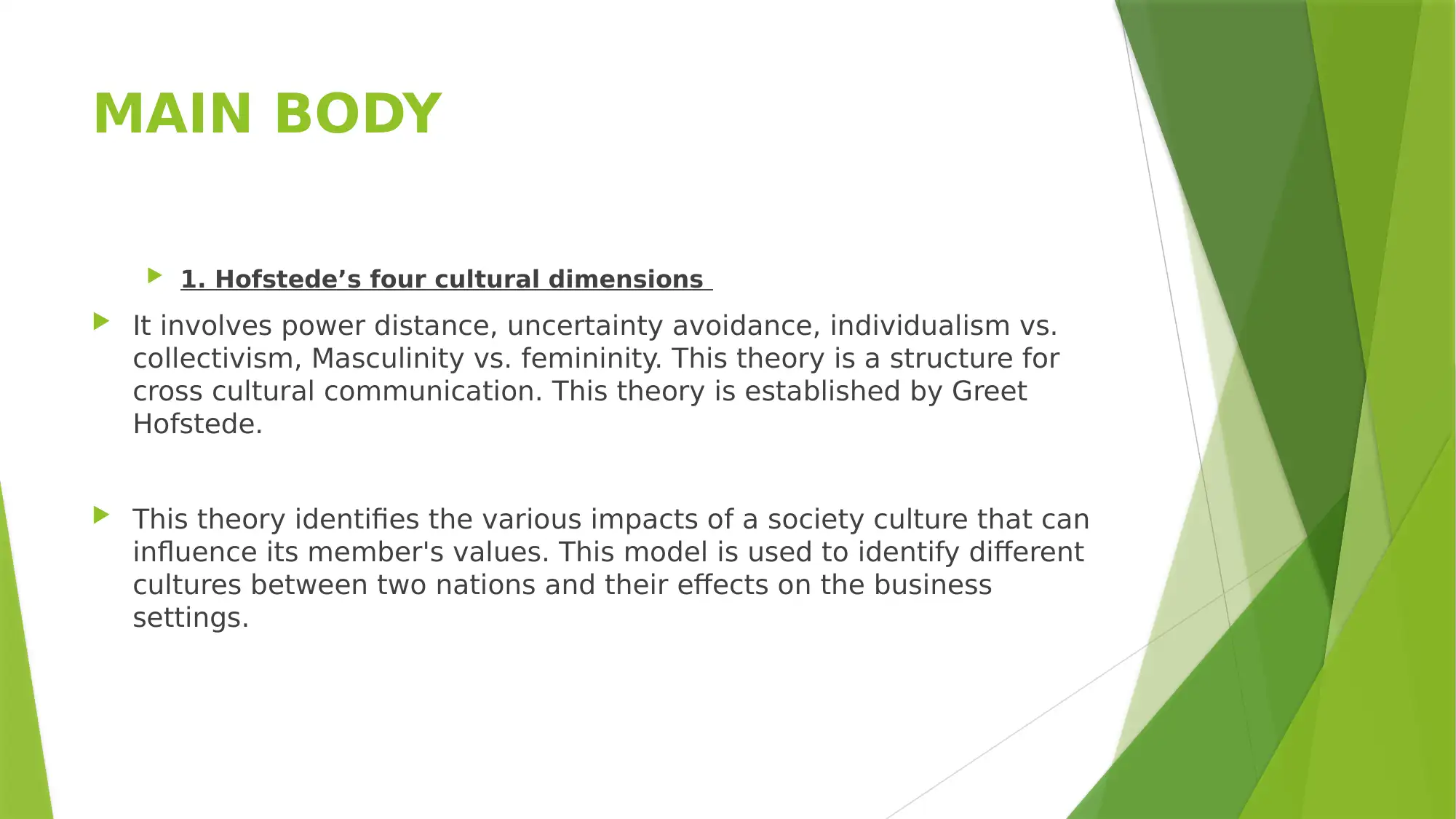
MAIN BODY
1. Hofstede’s four cultural dimensions
It involves power distance, uncertainty avoidance, individualism vs.
collectivism, Masculinity vs. femininity. This theory is a structure for
cross cultural communication. This theory is established by Greet
Hofstede.
This theory identifies the various impacts of a society culture that can
influence its member's values. This model is used to identify different
cultures between two nations and their effects on the business
settings.
1. Hofstede’s four cultural dimensions
It involves power distance, uncertainty avoidance, individualism vs.
collectivism, Masculinity vs. femininity. This theory is a structure for
cross cultural communication. This theory is established by Greet
Hofstede.
This theory identifies the various impacts of a society culture that can
influence its member's values. This model is used to identify different
cultures between two nations and their effects on the business
settings.
Paraphrase This Document
Need a fresh take? Get an instant paraphrase of this document with our AI Paraphraser
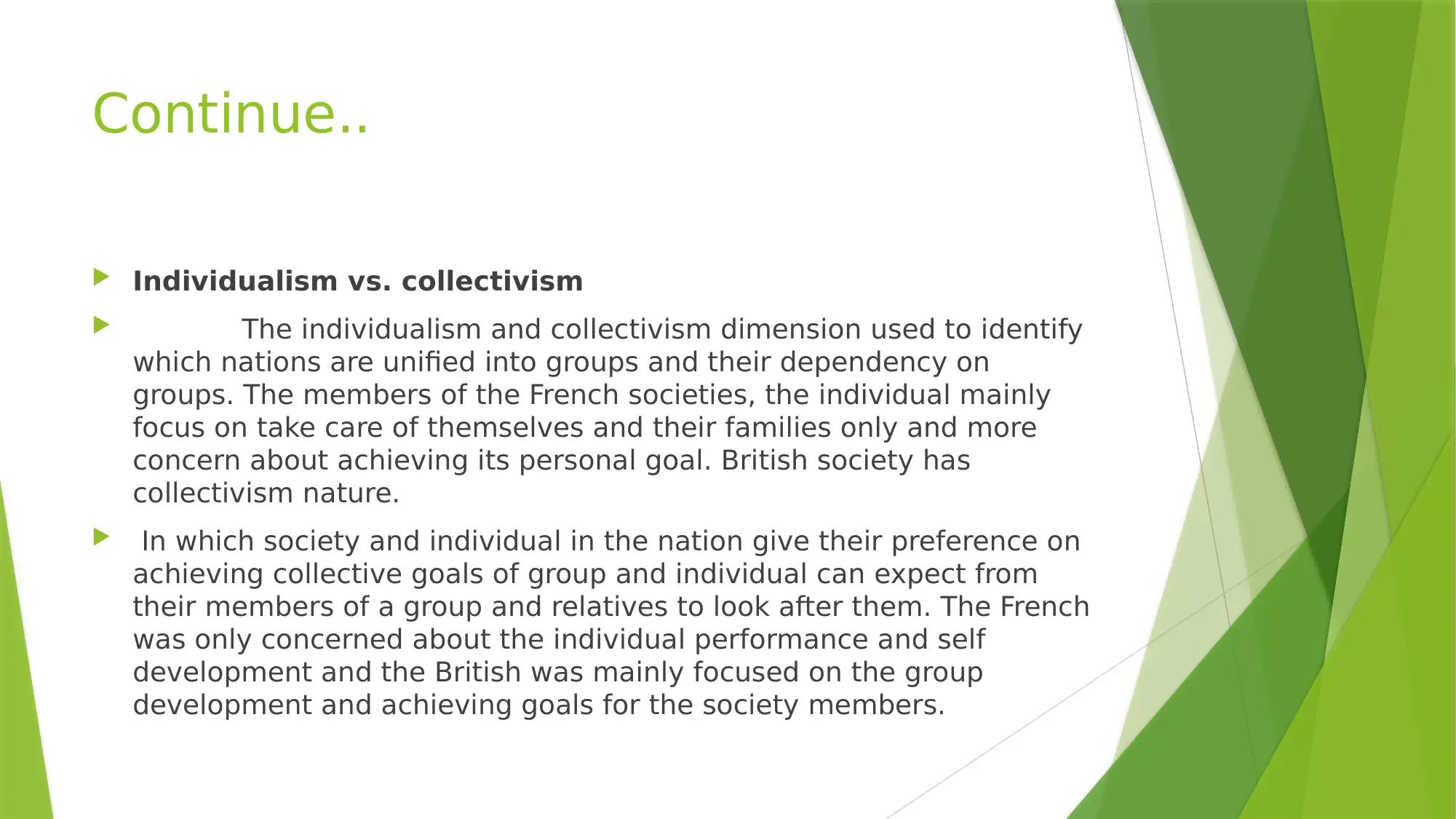
Continue..
Individualism vs. collectivism
The individualism and collectivism dimension used to identify
which nations are unified into groups and their dependency on
groups. The members of the French societies, the individual mainly
focus on take care of themselves and their families only and more
concern about achieving its personal goal. British society has
collectivism nature.
In which society and individual in the nation give their preference on
achieving collective goals of group and individual can expect from
their members of a group and relatives to look after them. The French
was only concerned about the individual performance and self
development and the British was mainly focused on the group
development and achieving goals for the society members.
Individualism vs. collectivism
The individualism and collectivism dimension used to identify
which nations are unified into groups and their dependency on
groups. The members of the French societies, the individual mainly
focus on take care of themselves and their families only and more
concern about achieving its personal goal. British society has
collectivism nature.
In which society and individual in the nation give their preference on
achieving collective goals of group and individual can expect from
their members of a group and relatives to look after them. The French
was only concerned about the individual performance and self
development and the British was mainly focused on the group
development and achieving goals for the society members.
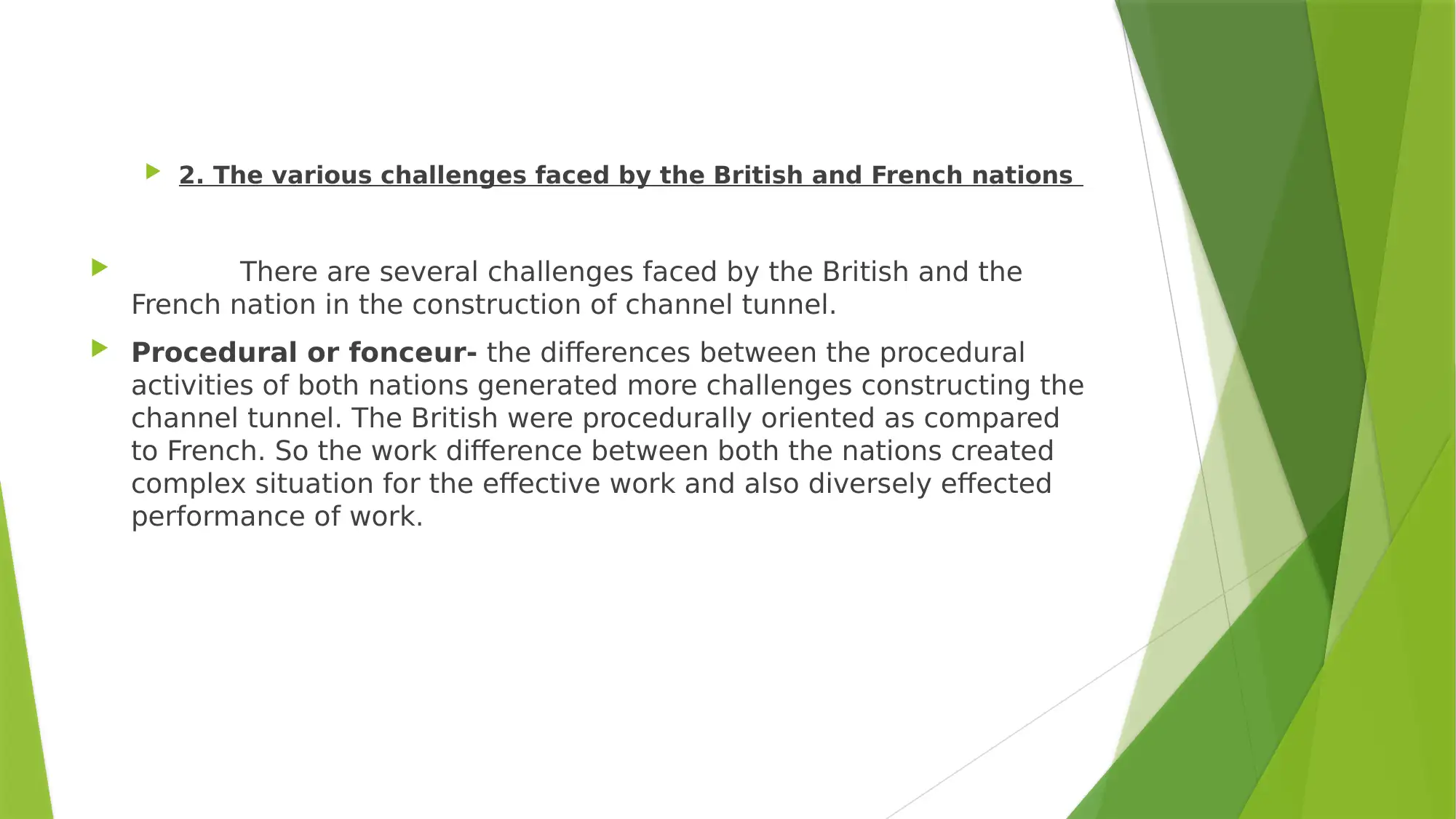
2. The various challenges faced by the British and French nations
There are several challenges faced by the British and the
French nation in the construction of channel tunnel.
Procedural or fonceur- the differences between the procedural
activities of both nations generated more challenges constructing the
channel tunnel. The British were procedurally oriented as compared
to French. So the work difference between both the nations created
complex situation for the effective work and also diversely effected
performance of work.
There are several challenges faced by the British and the
French nation in the construction of channel tunnel.
Procedural or fonceur- the differences between the procedural
activities of both nations generated more challenges constructing the
channel tunnel. The British were procedurally oriented as compared
to French. So the work difference between both the nations created
complex situation for the effective work and also diversely effected
performance of work.
⊘ This is a preview!⊘
Do you want full access?
Subscribe today to unlock all pages.

Trusted by 1+ million students worldwide
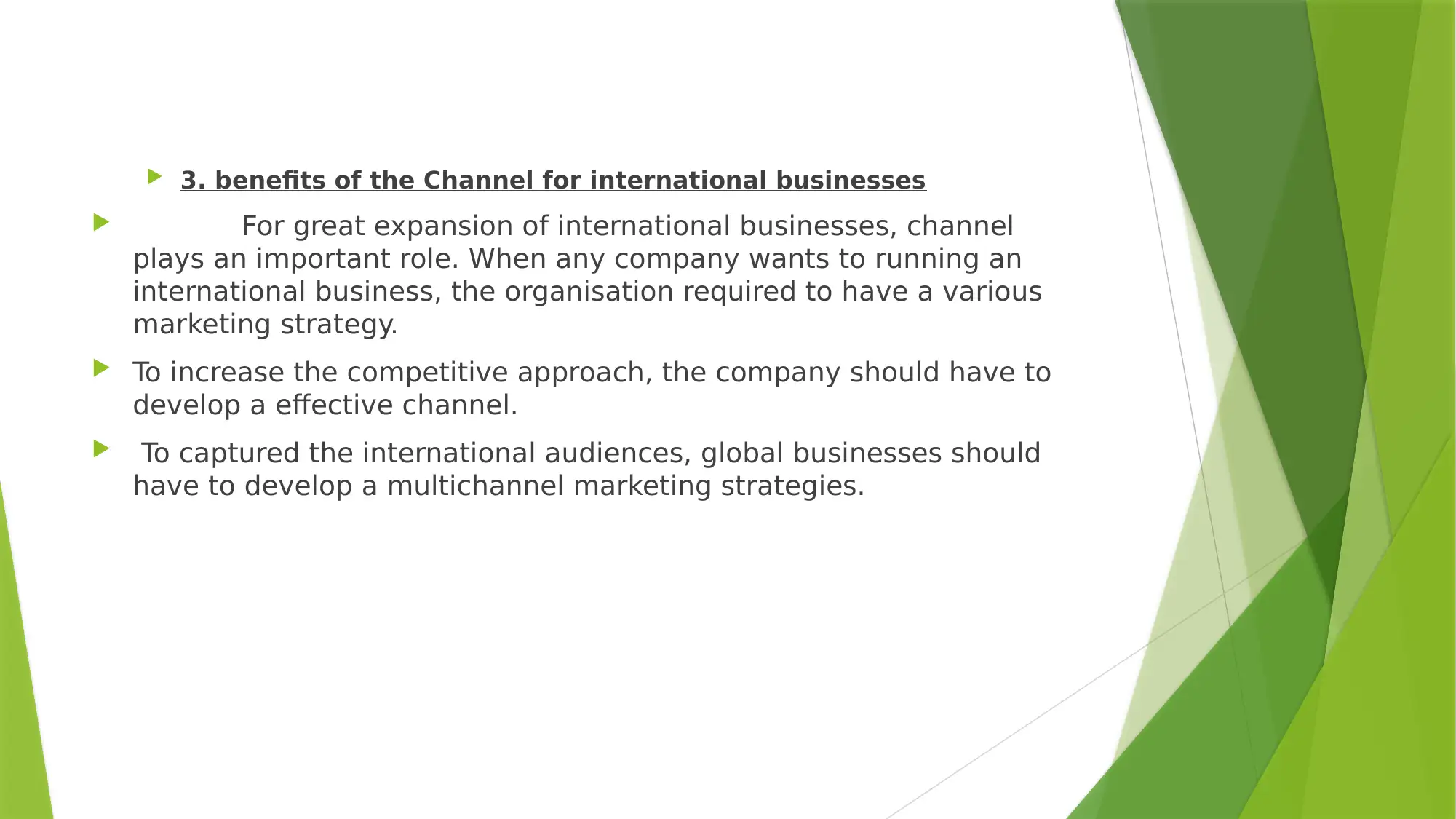
3. benefits of the Channel for international businesses
For great expansion of international businesses, channel
plays an important role. When any company wants to running an
international business, the organisation required to have a various
marketing strategy.
To increase the competitive approach, the company should have to
develop a effective channel.
To captured the international audiences, global businesses should
have to develop a multichannel marketing strategies.
For great expansion of international businesses, channel
plays an important role. When any company wants to running an
international business, the organisation required to have a various
marketing strategy.
To increase the competitive approach, the company should have to
develop a effective channel.
To captured the international audiences, global businesses should
have to develop a multichannel marketing strategies.
Paraphrase This Document
Need a fresh take? Get an instant paraphrase of this document with our AI Paraphraser
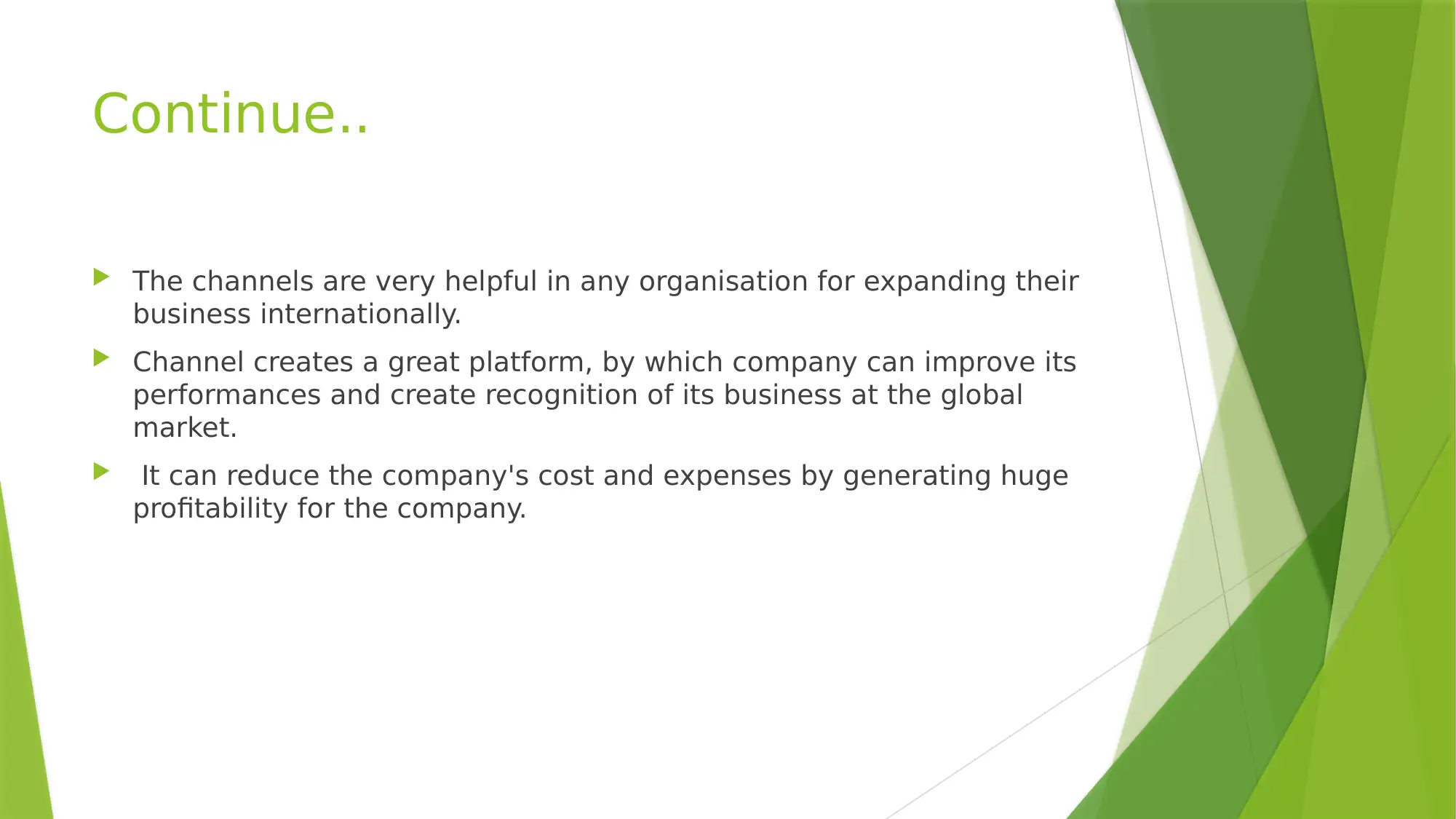
Continue..
The channels are very helpful in any organisation for expanding their
business internationally.
Channel creates a great platform, by which company can improve its
performances and create recognition of its business at the global
market.
It can reduce the company's cost and expenses by generating huge
profitability for the company.
The channels are very helpful in any organisation for expanding their
business internationally.
Channel creates a great platform, by which company can improve its
performances and create recognition of its business at the global
market.
It can reduce the company's cost and expenses by generating huge
profitability for the company.
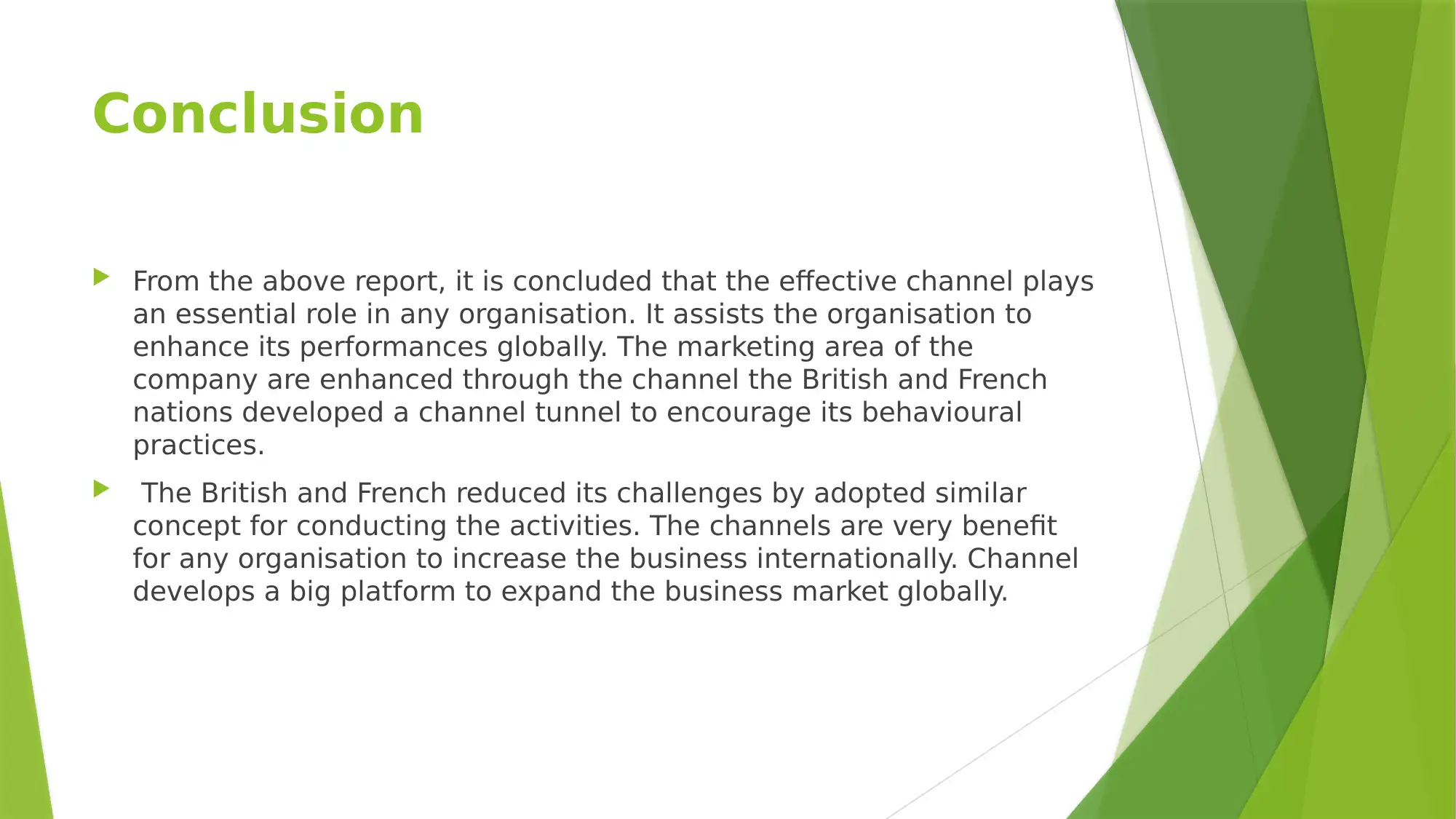
Conclusion
From the above report, it is concluded that the effective channel plays
an essential role in any organisation. It assists the organisation to
enhance its performances globally. The marketing area of the
company are enhanced through the channel the British and French
nations developed a channel tunnel to encourage its behavioural
practices.
The British and French reduced its challenges by adopted similar
concept for conducting the activities. The channels are very benefit
for any organisation to increase the business internationally. Channel
develops a big platform to expand the business market globally.
From the above report, it is concluded that the effective channel plays
an essential role in any organisation. It assists the organisation to
enhance its performances globally. The marketing area of the
company are enhanced through the channel the British and French
nations developed a channel tunnel to encourage its behavioural
practices.
The British and French reduced its challenges by adopted similar
concept for conducting the activities. The channels are very benefit
for any organisation to increase the business internationally. Channel
develops a big platform to expand the business market globally.
⊘ This is a preview!⊘
Do you want full access?
Subscribe today to unlock all pages.

Trusted by 1+ million students worldwide
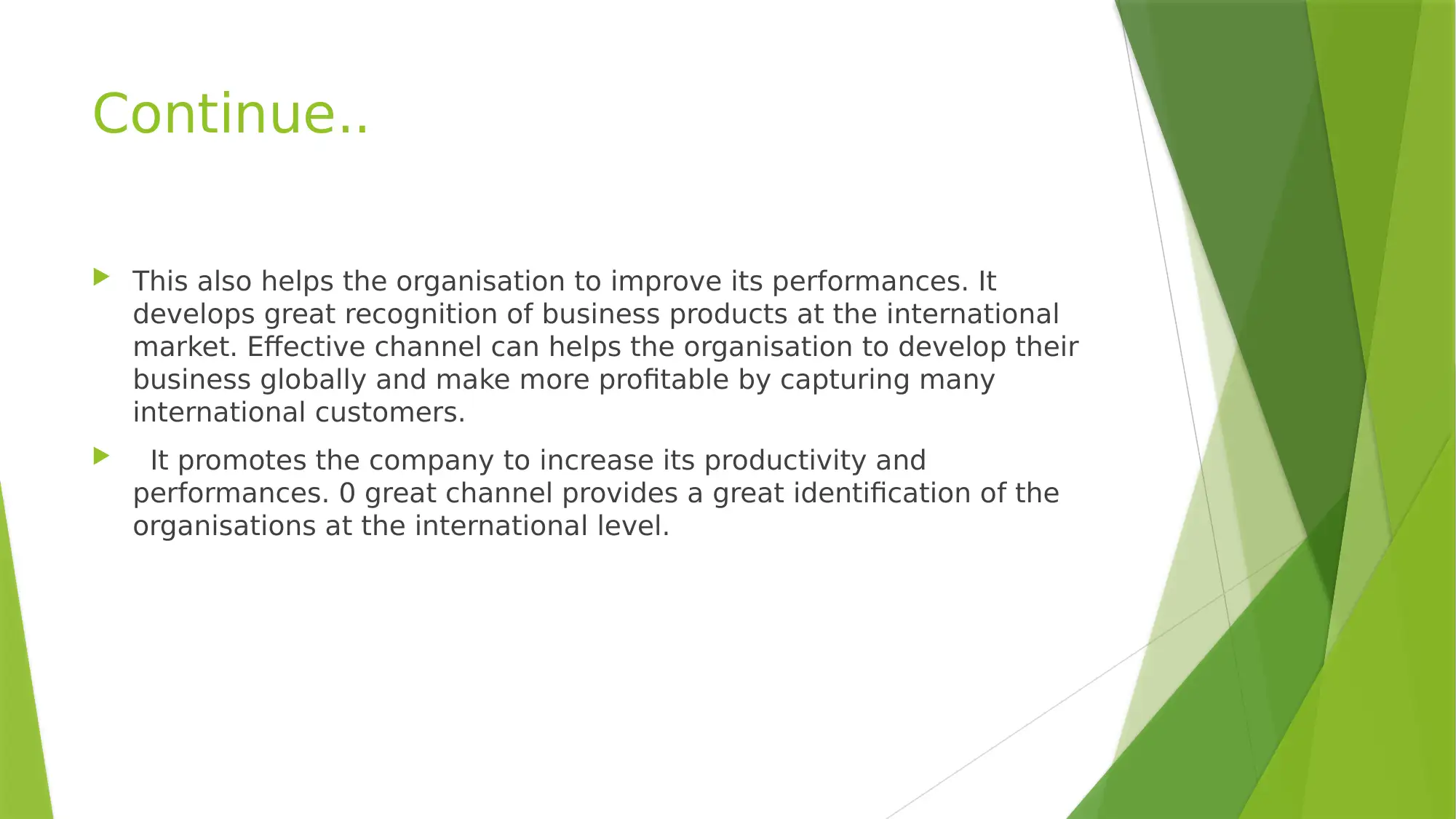
Continue..
This also helps the organisation to improve its performances. It
develops great recognition of business products at the international
market. Effective channel can helps the organisation to develop their
business globally and make more profitable by capturing many
international customers.
It promotes the company to increase its productivity and
performances. 0 great channel provides a great identification of the
organisations at the international level.
This also helps the organisation to improve its performances. It
develops great recognition of business products at the international
market. Effective channel can helps the organisation to develop their
business globally and make more profitable by capturing many
international customers.
It promotes the company to increase its productivity and
performances. 0 great channel provides a great identification of the
organisations at the international level.
Paraphrase This Document
Need a fresh take? Get an instant paraphrase of this document with our AI Paraphraser
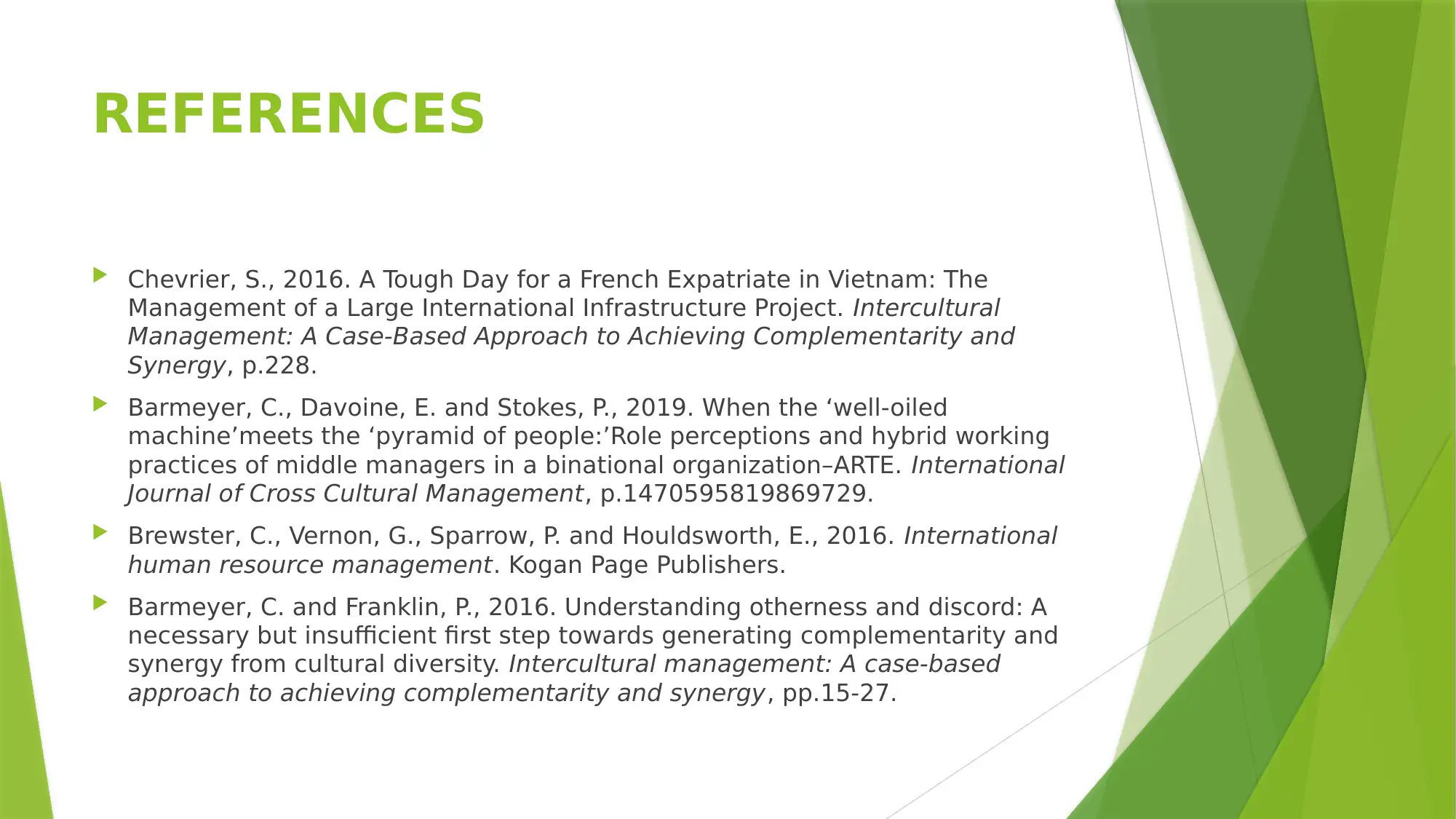
REFERENCES
Chevrier, S., 2016. A Tough Day for a French Expatriate in Vietnam: The
Management of a Large International Infrastructure Project. Intercultural
Management: A Case-Based Approach to Achieving Complementarity and
Synergy, p.228.
Barmeyer, C., Davoine, E. and Stokes, P., 2019. When the ‘well-oiled
machine’meets the ‘pyramid of people:’Role perceptions and hybrid working
practices of middle managers in a binational organization–ARTE. International
Journal of Cross Cultural Management, p.1470595819869729.
Brewster, C., Vernon, G., Sparrow, P. and Houldsworth, E., 2016. International
human resource management. Kogan Page Publishers.
Barmeyer, C. and Franklin, P., 2016. Understanding otherness and discord: A
necessary but insufficient first step towards generating complementarity and
synergy from cultural diversity. Intercultural management: A case-based
approach to achieving complementarity and synergy, pp.15-27.
Chevrier, S., 2016. A Tough Day for a French Expatriate in Vietnam: The
Management of a Large International Infrastructure Project. Intercultural
Management: A Case-Based Approach to Achieving Complementarity and
Synergy, p.228.
Barmeyer, C., Davoine, E. and Stokes, P., 2019. When the ‘well-oiled
machine’meets the ‘pyramid of people:’Role perceptions and hybrid working
practices of middle managers in a binational organization–ARTE. International
Journal of Cross Cultural Management, p.1470595819869729.
Brewster, C., Vernon, G., Sparrow, P. and Houldsworth, E., 2016. International
human resource management. Kogan Page Publishers.
Barmeyer, C. and Franklin, P., 2016. Understanding otherness and discord: A
necessary but insufficient first step towards generating complementarity and
synergy from cultural diversity. Intercultural management: A case-based
approach to achieving complementarity and synergy, pp.15-27.
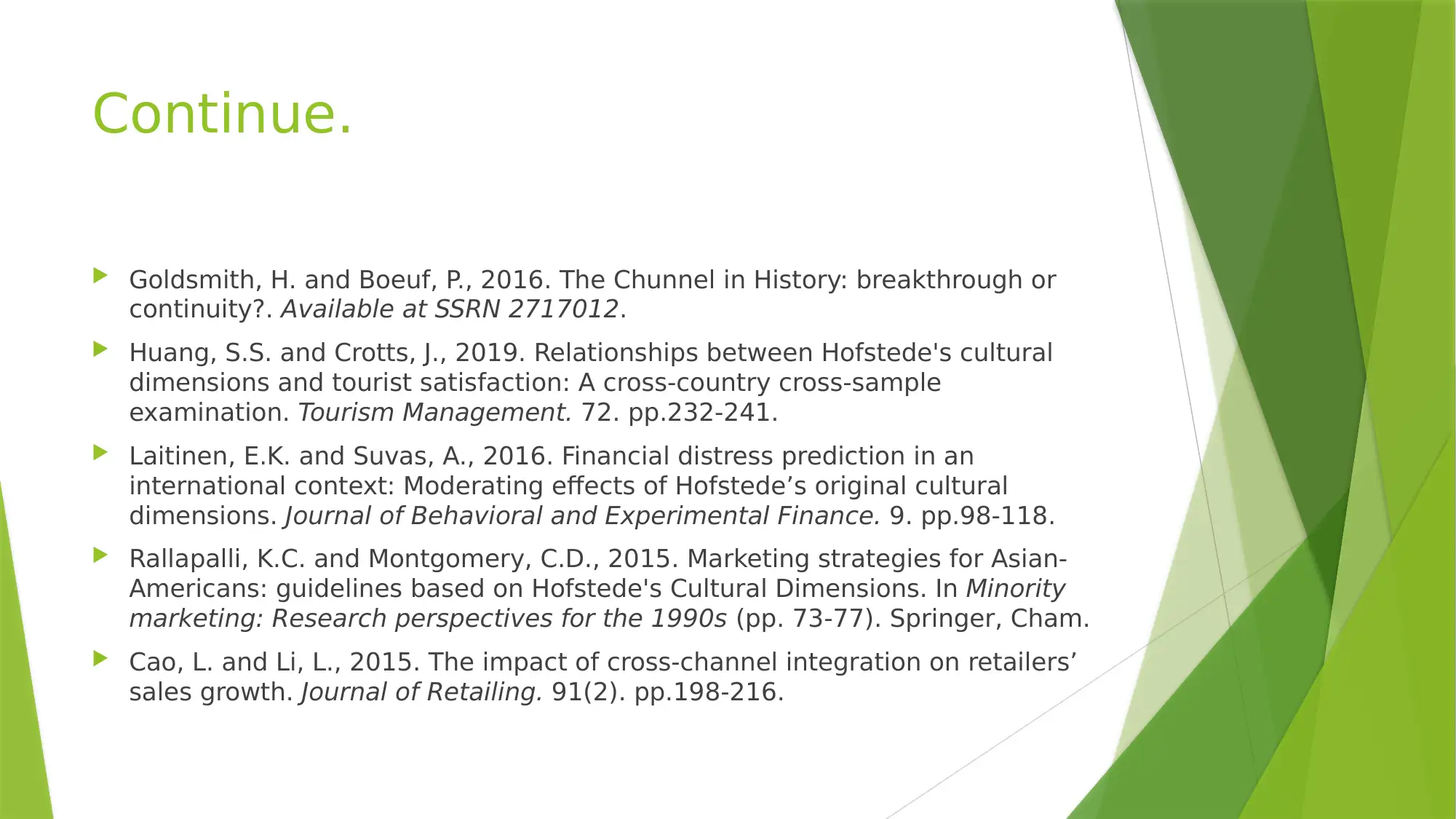
Continue.
Goldsmith, H. and Boeuf, P., 2016. The Chunnel in History: breakthrough or
continuity?. Available at SSRN 2717012.
Huang, S.S. and Crotts, J., 2019. Relationships between Hofstede's cultural
dimensions and tourist satisfaction: A cross-country cross-sample
examination. Tourism Management. 72. pp.232-241.
Laitinen, E.K. and Suvas, A., 2016. Financial distress prediction in an
international context: Moderating effects of Hofstede’s original cultural
dimensions. Journal of Behavioral and Experimental Finance. 9. pp.98-118.
Rallapalli, K.C. and Montgomery, C.D., 2015. Marketing strategies for Asian-
Americans: guidelines based on Hofstede's Cultural Dimensions. In Minority
marketing: Research perspectives for the 1990s (pp. 73-77). Springer, Cham.
Cao, L. and Li, L., 2015. The impact of cross-channel integration on retailers’
sales growth. Journal of Retailing. 91(2). pp.198-216.
Goldsmith, H. and Boeuf, P., 2016. The Chunnel in History: breakthrough or
continuity?. Available at SSRN 2717012.
Huang, S.S. and Crotts, J., 2019. Relationships between Hofstede's cultural
dimensions and tourist satisfaction: A cross-country cross-sample
examination. Tourism Management. 72. pp.232-241.
Laitinen, E.K. and Suvas, A., 2016. Financial distress prediction in an
international context: Moderating effects of Hofstede’s original cultural
dimensions. Journal of Behavioral and Experimental Finance. 9. pp.98-118.
Rallapalli, K.C. and Montgomery, C.D., 2015. Marketing strategies for Asian-
Americans: guidelines based on Hofstede's Cultural Dimensions. In Minority
marketing: Research perspectives for the 1990s (pp. 73-77). Springer, Cham.
Cao, L. and Li, L., 2015. The impact of cross-channel integration on retailers’
sales growth. Journal of Retailing. 91(2). pp.198-216.
⊘ This is a preview!⊘
Do you want full access?
Subscribe today to unlock all pages.

Trusted by 1+ million students worldwide
1 out of 13
Related Documents
Your All-in-One AI-Powered Toolkit for Academic Success.
+13062052269
info@desklib.com
Available 24*7 on WhatsApp / Email
![[object Object]](/_next/static/media/star-bottom.7253800d.svg)
Unlock your academic potential
Copyright © 2020–2025 A2Z Services. All Rights Reserved. Developed and managed by ZUCOL.





